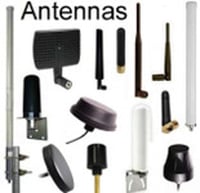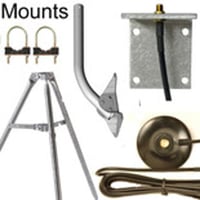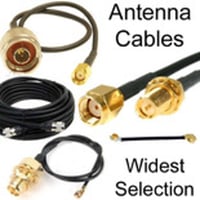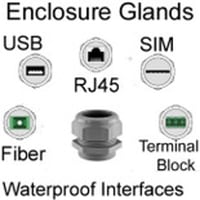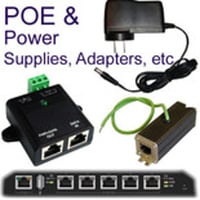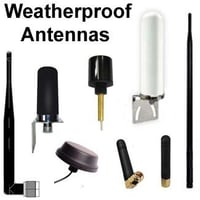Lightning Surge Protectors
Lightning Surge Protectors
Electronic devices and equipment including network and telecommunication tools are susceptible to damage caused by power surge. A power surge is an unexpected spike in power parameters that can be caused by electrostatic discharge, irregular power supply, poor wiring and the most common source being nearby lightning strikes.
Lightning strikes can cause severe power surge to delicate communication equipment such as access points, bridges, antennas and transmitters through Ethernet and antenna cables. Lightning surge protectors are proven to provide an acceptable level protection from lightning surges, avoiding equipment malfunction and even damage.
The lightning surge protectors work by eliminating power spikes along transmission cables. They are connected to the cable in a back-to-back junction, either Ethernet or coaxial cable. The surge protector shunts any transient charges through a semiconductor to a ground reference.
Surge protectors are available for RJ45 Ethernet connectors and a variety of coaxial connectors including the popular N-type, SMA, and RP-SMA at their rated frequencies.
Lightning surge protectors are rated with a specific clamping voltage. This is the maximum voltage that can pass through a surge protector. They also have an energy absorption rating expressed in joules, this is the maximum amount of energy the device can absorb in its lifetime before a malfunction or permanent failure. Typical lightning protectors for telecommunication equipment are rated at 70V and 400-600 Joules.
Data Alliance's L-mounts are compatible to mount lightning surge arrestors with N-type, SMA, and RP-SMA connectors.
Lightning Surge Protectors for Wireless Gear
A Lightning Surge Protector, Surge Arrestor, Transient Voltage Surge Suppressor, or Surge Protective Device (SPD) is an electrical device that is installed in electrical, electronic, and communication or networking systems to protect them from overvoltage caused by lightning and other events. Even though lightning strikes are infrequent, the damage that takes place when they do occur can be devastating. If no SPD is installed to divert the harmful voltage away from the equipment, irreparable damage to equipment can occur.
These devices are usually connected in-line with the conducting element or cable ahead of the conductor's entrance to the device that is to be protected. The SPD uses a varistor mechanism to separate the excess voltage then routes this energy from the lightning strike to the ground and away from the downstream device.
They are an essential component in electrical circuits and networking and telecommunications infrastructure. The device works to limit the voltage spike by diverting the excess voltage away from downstream devices and components and limiting any overvoltage to a level that will not damage the connected equipment.
Lightning is a well-known cause of overvoltage or electrical surges. The frequency of occurrence of thunderstorms will vary by location. Lightning can directly hit electrical and electronic components like antennas (known as a direct strike) or transfer power to an electrical system by occurring nearby (an indirect strike). In both cases, without suitable protection, the lightning immediately causes the following 4 problems:
-
Disruption: The overvoltage from lightning does not physically damage equipment but there is a disruption of the analog or processing functions of downstream devices. The effects are experienced as data loss, corruption of software, and computer crashes. In most cases, a system reset will correct the problem without any lingering problems.
-
Degradation: Recurrent episodes of transient overvoltage can break down the electrical components within a device or system, shortening their lifespan and increasing the risk of sudden failure.
-
Damage: A direct lightning strike is almost certainly going to damage unprotected components. Severe effects of this overvoltage include:
-
Insulation and dielectric degradation
-
Burnt out and charred circuit boards and I/O cards
-
Ruptured casings
-
Fire
-
The more severe manifestations of lightning damage are due to power follow-on and not the transient overvoltage itself. The damage sustained by the equipment may not be a reliable indicator of the magnitude of overvoltage that took place. If short-circuiting occurs, it can route the power and show no outward signs of damage.
-
Downtime: This includes the follow-on effects of equipment or networks being shut down by degraded or damaged components. The economic costs, explored below are significant and also, there is the loss of time, data, and productivity.
Types of Lightning Surge Protection Devices
-
Gas Discharge Tubes or coaxial cable lightning arrestors are a type of arrestor commonly used in-line with coaxial cables and telecommunications equipment. They specifically protect radio devices from the effects of lightning. These surge arrestors contain glass tubes that are filled with a gas that will only conduct electricity if the voltage across conducting electrodes within the arrestor exceeds a certain threshold. A transient spike in voltage across the Gas Tube Arrestor ionizes the gas, creating a short circuit that diverts the excess energy away from connected devices. These arrestors are capable of dispersing large amounts of energy in this way.
-
Spark Gap devices consist of two conducting electrodes with a gas-filled gap, that allows an electric spark to cross from one conductor to the other when the voltage exceeds the breakdown voltage of the gas within the gap. The presence of a surge or transient overvoltage ionizes the gas, reducing its resistance and creating a path for the excess electrical energy to be diverted to the ground as efficiently as possible.
Also, there are three internationally standardized types of Surge Protection Devices:
-
Type 1 Surge Protection Devices are designated to protect against surge events that are transient like overvoltages from direct lightning strikes. These lightning surge protectors can discharge the excess voltage from the lightning strike and stop it from spreading from an earth conductor to network or circuit conductors.
-
Type 2 Surge Protection Devices are designed to protect devices and networks from damage due to switching or indirect lightning strikes. When installed in low-voltage electrical systems they prevent the spread of overvoltage.
-
Type 3 Surge Protection Devices provide special protection for sensitive loads and have a low discharge capacity. They cannot fully protect in their own right but are installed with Type 2 devices and hard-wired near to sensitive loads. They are frequently used in telecommunications applications.
Typical physical and electrical features of in-line coaxial Lightning Surge Arrestors
SPDs that are designed for insertion into coax transmission lines will carry standard radio frequency connectors including the RP-SMA, SMA,and N-Type connectors at both ends.
They typically have a cylindrical or cuboidal body and have a center conductor running through them inline with coaxial cable construction. They are usually made from nickel-plated brass, with a Teflon insulator.
Coaxial cable lightning arrestors need to connect to an earth grounding system. Many arrestors will carry a grounding screw on the arrestor body that also carries a solder lug to facilitate the attachment of a substantial grounding wire that can be used to divert the excess current to the earth quickly and with low resistance.
The center conductor within the arrestor is surrounded by a small air gap between the conductor and the arrestor's grounded body. In the event of a lightning strike, a high voltage traveling through the coaxial cable and into the lightning arrestor will arc across the air gap and divert potentially damaging currents to the earth, sparing the onward transmission line and downstream devices.
The size of the gap determines the flashover voltage at which any overvoltage is diverted. Many arrestors have screw gap adjustments to change the size of the air gap size.
Lightning surge protection for Ethernet
It is now widely recognized that Ethernet ports can also be affected by lightning with damage and disruption of networks.
Outdoor Ethernet cable installations and CCTV are known to be vulnerable to direct lightning strikes.
Remote lightning strikes with powerful electromagnetic pulses can induce transient current by near field and far-field coupling in both PoE and data cables. Dysfunction of the network is often more apparent than physical damage even where the lightning strike is direct.
By installing inline Surge Protection Devices for Ethernet in PoE circuits and horizontal cabling, networks can be secured from overvoltage that is due to lightning strikes or switching. Arrestors for Information Technology Systems include Ethernet Gas Discharge Tubes with integrated earthing and a Cat5 or Cat 6 Ethernet port that is compatible with the RJ45 plug.
Gas Discharge Tubes for Ethernet have good power handling and protect against transients of varying size and duration. They can be used on key Ethernet networking components including:
- Router
- Switches/injectors
- Repeaters
- Modem
Like coaxial cable, these Ethernet lightning arrestors intercept overvoltage and divert it to an externalized earthing wire. A gas discharge tube is present for each of the 4 twisted pairs of the cable.
Diode-based Ethernet arrestors consist of a diode array that delivers protection for each of the 8 channels (wires) of an Ethernet port. They are highly efficient in suppressing lightning surges. If a diode-based arrestor encounters an above threshold transient voltage surge the impedance of the affected diode will drop, creating a shunt path for the overvoltage away from the data line.
High-performance RoHS compliant Lightning Surge Arrestors
Our extensive selection of in-line lightning surge protectors is manufactured with materials of high quality and good provenance. All products are compliant with the Restriction of Hazardous Substance (RoHS) directive, European Union legislation that limits the use of hazardous substances like lead or cadmium in electronics.
These Lightning Surge Protectors comply with domestic and international law relating to the conflict minerals Tin, Tantalum, Tungsten, and Gold (3TG), in particular, The Conflict Minerals Regulation and Section 1502 of the Dodd-Frank Act.
In the US the majority of Lightning Surge Protectors are manufactured by companies that are members of the Surge Protection Institute of the National Electrical Manufacturers Association (NEMA). Manufacturers design and test arrestors using a variety of lightning waveforms that simulate a direct lightning strike. Effective lightning arrestors need to provide a defined level of protection and handle peak current that can exceed 25,000 amperes.
Why is Lightning Surge Protection important?
The impact of damage to electrical and electronic devices from lightning and other sources of electrical surging is significant. According to the National Lightning Safety Institute, lightning damage to electrical equipment costs the US economy up to $6 billion annually, despite being responsible for only 20% of surge events. The electronic damage can shorten equipment lifespan, precipitate malfunctions, and even start fires.
As the industrial, commercial, and domestic consumption of electronics increases so does the susceptibility for infrastructure, networks, and economic productivity to be impacted by surges. Downtime is costly, with critical facilities losing up to $130,000 with each event.
With more and more networking, and electronic devices performing critical tasks in society, there is a need for properly safeguarding their function from surges.
Most voltage spikes encountered by electronic equipment are low energy but lightning can be detrimental to electronic systems and devices. The short-lived increase in voltage in power, data, or radiofrequency lines caused by lightning are known as surges or transients and can be extremely destructive to a wide range of equipment including:
- Cellular base stations and exchanges
- Wireless networking equipment
- Digital signage and media players for outdoor advertising
- Antennas
- Computing equipment and servers
- CCTV equipment
- Building management systems
- Alarm systems
- Low Noise Amplifiers (LNAs)
- Signal repeaters and boosters
Overvoltages due to lightning can also present an electric shock hazard if there is a flashover that exceeds the ability of the equipment or cable insulation to withstand the increased voltage.
Protecting electronic equipment with a suitable Surge Protection Device (SPD) is critical for maintaining the functionality of devices and network uptime and operation. SPDs are essential because fuses and circuit breakers, known as overcurrent devices, are unable to provide overvoltage protection. SPDs are designed to deliver specific protections from the short high-voltage spikes that occur with a direct lightning hit.
Frequently asked questions
What are Surges?
A surge or transient is a short-lived increase in power (current or voltage), in a circuit where the subcycle overvoltage has a duration (measured in milliseconds or microseconds) that is less than half of a normal power waveform cycle. Surges are often oscillatory, varying in polarity, and can be additive or subtractive in their deviance from the normal voltage waveform. They have a degrading effect on the electrical equipment that is exposed to them.
Surges can be generated inside or outside a building, with the vast majority (60-80%) of surges originating from within a building. With mains power, the conductors involved are the line, neutral, and earth. In radio frequency circuits the signal line and the earth are affected.
Key internal causes of surges include:
-
Electrical load switching: the switching on and off of electrical loads are a common precipitant of surges in an electrical system. A notable example of this is the recovery of power after an outage, Though switching surges are often not as large in magnitude as lightning strikes they are operational and often more frequent and damaging over time.
-
Inductive coupling: the electromagnetic field generated by current flowing through a wire is capable of transiently inducing a voltage in nearby wiring or materials.
-
Static electricity: also known as ESD is described further on.
Other than lightning, external causes of surges or transients include:
-
Grid and capacitor bank switching undertaken by the utility company in response to faults can lead to faults an interrupted power supply is reconnected.
-
Adjustments in the allocation of power by utility companies can also cause surges.
-
Power quality disturbances and their correction.
Electrical and electronic equipment will have varying ability to withstand variations in their normal operating voltage but the significant electrical discharge from lightning will be damaging to almost all equipment.
What is Electrostatic Discharge (ESD)?
Electrostatic Discharge is a spontaneous discharge or flow of electrical current between two charged surfaces or objects that have stored up static electricity in a capacitive manner. This usually occurs with differently charged surfaces, where a dielectric that was previously present has broken down or been removed. Electrical current can build up in materials through electrostatic induction where charge is transferred from a conductive object that is not grounded.
Lightning is essentially a massive electrostatic discharge event, with thunder being the accompanying sound. Typical ESD events are nowhere as large or dramatic but are still capable of doing significant damage to electronic devices and equipment.
The threshold voltage for human perception of an ESD is 2000 to 3000 Volts but discharges below this voltage still contain enough energy to damage electronics. The fast initial slopes of current waveforms generated by ESD are disruptive even at lower voltages.
ESD is such a significant cause of electronic device failure that manufacturers will go to great lengths to prevent its occurrence and protect components. Several strategies are used including separating highly charged materials in an electrostatic protection area (EPA), grounding workers, ionization systems, regulating the humidity, or using antistatic devices. The requirement for ESD protection even continues to the packaging and shipping of electronic equipment as well as grounding during installation. Despite these efforts, ESD cannot be completely prevented when devices or components are handled.
What is Lightning Electromagnetic Impulse (LEMP)?
Electromagnetic Pulse damage is another form of damage to electronics that can be caused by lightning. It is usually caused by an indirect lightning strike. The high voltage discharge of nearby lightning is also high current and carries a correspondingly strong magnetic field.
The strength of the field means that it can induce currents in nearby unprotected cables and electronics. Unlike the line surges, LEMP induces large electrical currents within devices and networks that can damage them, especially if they are switched on. SPDs offer limited protection against EMPs. The best protection is to disconnect, where possible, devices that are at risk of exposure to a LEMP when not being actively used.
In conclusion
Lightning surge protectors are critical components for securing telecommunications, radio, and networking equipment against the damage of both direct and indirect lightning strikes.
Being prepared for a lightning strike on your network installation provides the best opportunity to maintain uninterrupted system operation.
In addition to integrating these SPDs, being aware of the systems that are most vulnerable to failure, keeping spare parts on hand, and backing up data are strategies that will preserve the integrity of your network.
LEARN MORE:

